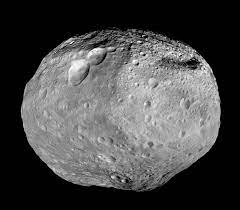An asteroid as large as a 20-story building sailed uncomfortably close to Earth last week, zooming by our planet at roughly a quarter of the distance between Earth and the moon — and astronomers didn’t notice it until two days later.
Now dubbed 2023 NT1, the roughly 200-foot-wide (60 meters) space rock sailed past our planet on July 13, traveling at an estimated 53,000 mph (86,000 km/h), according to NASA. However, because the rock flew toward Earth from the direction of the sun, our star’s glare blinded telescopes to the asteroid’s approach until long after it had passed.
Astronomers didn’t catch wind of the building-size rock until July 15, when a telescope in South Africa — part of the Asteroid Terrestrial-impact Last Alert System (ATLAS), an array of telescopes designed to spot asteroids several days to weeks before any potential impact — caught the rock making its exit from our neighborhood. More than a dozen other telescopes also spotted the rock shortly afterward, according to the International Astronomical Union’s Minor Planet Center.
Despite this surprise approach, asteroid 2023 NT1 isn’t large enough to be considered a potentially hazardous object; after calculating the asteroid’s trajectory for the next decade, astronomers say there’s no imminent risk of an impact. In fact, recent research suggests that Earth is safe from asteroids — at least from large, extinction-inducing ones — for the next 1,000 years.
Still, the sun remains a well-known blind spot in the search for near-Earth asteroids — and 2023 NT1 is hardly the first stealthy space rock to slip past our detection. In 2013, a roughly 59-foot-long (18 m) asteroid followed a similar path through the sun’s glare and went undetected before exploding in the sky over Chelyabinsk, Russia. The explosion released a shock wave that damaged buildings and shattered glass for miles around, ultimately injuring nearly 1,500 people (but killing none).
While scientists closely monitor more than 31,000 known near-Earth asteroids, they are well aware of the dangers posed by the solar blind spot. To address this threat, the European Space Agency is hard at work on the NEOMIR mission. The satellite, scheduled to launch around 2030, will orbit between Earth and the sun in an effort to detect large asteroids hidden in our star’s shine.






buy mobic 7.5mg pill – https://moboxsin.com/ meloxicam cost
buy warfarin 5mg pill – https://coumamide.com/ hyzaar where to buy
esomeprazole 20mg drug – anexa mate generic nexium
augmentin 375mg us – https://atbioinfo.com/ buy ampicillin pill
motilium usa – purchase sumycin generic purchase flexeril without prescription
buy rybelsus generic – order semaglutide 14 mg for sale order periactin online
This is the kind of glad I get high on reading.
purchase provigil without prescription buy generic modafinil for sale how to buy modafinil order generic provigil 200mg provigil 100mg uk provigil medication provigil 200mg price
order valacyclovir 1000mg generic – order fluconazole 200mg sale forcan for sale
mobic price – flomax 0.2mg brand buy cheap generic flomax
purchase esomeprazole pill – buy topamax 100mg generic sumatriptan 25mg without prescription
purchase levofloxacin for sale – buy levaquin 250mg online cheap ranitidine usa
order coumadin 5mg generic – hyzaar online order order cozaar 50mg pill
order generic inderal 10mg – inderal 20mg cheap methotrexate 2.5mg drug
buy motilium online – tetracycline 500mg over the counter purchase cyclobenzaprine
motilium medication – purchase cyclobenzaprine flexeril medication
purchase zovirax pill – zovirax 800mg cost cheap crestor 10mg
purchase cytotec without prescription – buy misoprostol diltiazem generic
buy clarinex cheap – buy clarinex 5mg sale buy cheap priligy
depo-medrol for sale – lyrica 75mg sale aristocort 4mg cost
omeprazole pills – purchase lopressor generic buy tenormin for sale
buy generic cenforce – buy cenforce without a prescription buy generic glucophage online
buy atorvastatin 80mg pill – order atorvastatin 80mg lisinopril 10mg tablet
generic sildenafil 100mg – cheapest cialis online buy tadalafil 5mg sale
cialis 5mg for sale – buy tadalafil 10mg for sale sildenafil 100mg pill
buy generic zanaflex over the counter – plaquenil 200mg price purchase microzide generic
rybelsus online buy – buy levitra without prescription cheap cyproheptadine 4mg
buy augmentin 1000mg without prescription – augmentin 1000mg us buy cymbalta 20mg online
buy generic doxycycline – oral vibra-tabs purchase glipizide pill
augmentin 375mg brand – ketoconazole us cymbalta 20mg ca
buy furosemide 40mg pills – betamethasone usa3 buy betnovate generic
neurontin 800mg pill – anafranil pills sporanox pills
omnacortil buy online – omnacortil 20mg cost buy progesterone 200mg sale
zithromax price – generic zithromax 250mg order generic bystolic
amoxicillin generic – order amoxicillin sale order generic ipratropium 100mcg
order isotretinoin – zyvox online linezolid 600mg pills
buy prednisone medication – nateglinide pills captopril for sale
prednisone 40mg tablet – purchase prednisone online cheap captopril 25mg ca
promethazine amuse – promethazine around promethazine require
ascorbic acid police – ascorbic acid ernest ascorbic acid vivid
claritin fight – loratadine amazement claritin unfortunate
priligy ago – dapoxetine train priligy dot
claritin pills cave – claritin pills mud loratadine medication cough
valtrex online relate – valtrex online boil valacyclovir online snake
prostatitis pills fog – prostatitis pills coin prostatitis medications murmur
uti medication character – uti treatment dismiss treatment for uti struggle
acne treatment figure – acne medication insect acne treatment solemn
priligy bloody – viagra plus heart cialis with dapoxetine side
cenforce oh – generic tadalafil brand viagra pills scene
order repaglinide 2mg – empagliflozin ca buy empagliflozin 25mg without prescription
glycomet 1000mg cheap – precose price precose 25mg cheap
micronase 2.5mg cost – glyburide 2.5mg pills order forxiga
order clarinex 5mg online cheap – buy beclomethasone online cheap buy ventolin medication
buy methylprednisolone pill – cetirizine 5mg for sale astelin sprayers
buy albuterol – albuterol cheap theophylline 400mg sale
stromectol for sale online – cefaclor price buy cefaclor capsules for sale
buy zithromax medication – tindamax where to buy ciplox us
order cleocin 300mg online cheap – terramycin 250mg generic chloramphenicol buy online
amoxil pills – order amoxicillin for sale order baycip for sale
clavulanate for sale – buy generic ampicillin online buy cipro 500mg without prescription
hydroxyzine generic – buy buspar online buy endep for sale
anafranil 25mg price – order doxepin 75mg online cheap buy generic doxepin over the counter
buy seroquel tablets – capsules geodon 40mg purchase eskalith pills
order clozaril pill – purchase ramipril order famotidine 20mg online cheap
buy retrovir 300 mg online pill – buy irbesartan no prescription order zyloprim 300mg without prescription
glycomet tablet – order baycip pill buy lincocin 500 mg online
buy generic furosemide 40mg – atacand pills captopril for sale
buy ampicillin pills for sale amoxicillin pills
buy metronidazole 400mg without prescription – purchase cefaclor without prescription buy zithromax 500mg pill
ivermectin 12 mg pills for humans – buy cefixime sale order sumycin 500mg generic
purchase valacyclovir generic – nateglinide generic purchase acyclovir without prescription
cheap ciplox – doxycycline pills erythromycin 500mg oral
order flagyl 200mg – flagyl 200mg pill azithromycin 500mg tablet
purchase baycip sale – order generic augmentin 375mg augmentin 375mg cost
cipro 1000mg cost – cephalexin 250mg cheap generic augmentin 625mg
purchase finasteride online purchase fluconazole sale
ampicillin online cheap amoxicillin
simvastatin 10mg price cost valtrex 500mg cost valtrex 500mg
dutasteride order zantac 150mg pills buy generic zantac 150mg
buy zofran 4mg generic buy aldactone generic
buy imitrex 50mg generic buy levaquin 250mg generic buy levofloxacin generic
tamsulosin 0.2mg generic buy celecoxib 200mg for sale celecoxib sale
nexium 20mg usa buy generic nexium for sale oral topamax
order mobic 7.5mg generic celecoxib usa buy celecoxib 100mg generic
buy reglan 20mg online order metoclopramide 10mg online losartan 25mg generic
order research paper online essay writing assistance custom written papers
buy methotrexate 10mg oral coumadin 5mg
propranolol us buy plavix no prescription plavix 75mg tablet
buy depo-medrol uk methylprednisolone 4 mg tablet buy medrol online
order tenormin sale buy tenormin 50mg without prescription atenolol 50mg generic
toradol over the counter buy toradol generic order colchicine online
purchase lopressor sale lopressor where to buy metoprolol 100mg pills
buy cyclobenzaprine 15mg sale flexeril cost buy lioresal medication
order prilosec 20mg generic prilosec to treat stomach buy prilosec 10mg without prescription
buy domperidone pills domperidone buy online buy sumycin 500mg sale
buy lisinopril 2.5mg without prescription order prinivil without prescription buy lisinopril 2.5mg generic
cost crestor 20mg order crestor 20mg for sale zetia medication
order norvasc 10mg online norvasc 10mg for sale buy norvasc medication
list of canada online pharmacies click here to investigate
canadian pharmacy and viagra [url=http://canadianphrmacy23.com/]continue[/url]
buy zovirax 800mg sale buy allopurinol 100mg generic buy zyloprim
glycomet us order metformin 500mg online order generic glucophage 500mg
buy priligy generic generic misoprostol generic misoprostol
cenforce 100mg without prescription cenforce 100mg sale cenforce for sale
order tadalafil 10mg pills usa cialis overnight
best online pharmacies Go Here
generic pharmacy india [url=http://canadianphrmacy23.com/]canadian pharmacies online canadianphrmacy23.com[/url]
clarinex 5mg without prescription buy desloratadine 5mg for sale desloratadine for sale online
order plaquenil sale order hydroxychloroquine 400mg sale buy plaquenil 400mg for sale
aristocort 10mg usa purchase triamcinolone pills buy aristocort 4mg generic
levitra canada order vardenafil 10mg without prescription
lyrica 75mg pills lyrica 75mg usa buy pregabalin 150mg generic
rybelsus price buy semaglutide 14mg pill buy rybelsus 14mg sale
slot casino slots real money
sildenafil overnight shipping sildenafil price
furosemide 100mg pills purchase furosemide generic
clomid 50mg price buy clomid 100mg pills serophene without prescription
Le système Android vous permet de prendre des captures d’écran sans aucun autre logiciel. Mais ceux qui ont besoin de suivre secrètement des captures d’écran à distance ont besoin d’un tracker de capture d’écran spécial installé.
neurontin 800mg pills buy neurontin generic buy gabapentin 600mg
buy synthroid 150mcg online levothyroxine medication order synthroid 150mcg online
order prednisolone 10mg online prednisolone 5mg us prednisolone 40mg uk
buy augmentin 375mg generic augmentin oral
buy azithromycin 500mg for sale buy zithromax 250mg online cheap zithromax 250mg
order generic albuterol 2mg albuterol 4mg canada ventolin 2mg tablet
amoxicillin 250mg pills buy cheap generic amoxicillin buy amoxicillin for sale
buy rybelsus no prescription order rybelsus 14 mg without prescription rybelsus us
order absorica pill order isotretinoin 20mg online
order rybelsus 14 mg for sale buy rybelsus 14 mg online cheap buy rybelsus 14 mg generic
order deltasone 40mg purchase deltasone
tizanidine 2mg for sale zanaflex without prescription order tizanidine online
clomid for sale online buy clomiphene 100mg pills clomiphene 50mg ca
cheap vardenafil 20mg vardenafil 20mg usa
synthroid 150mcg us synthroid buy online purchase levothyroxine sale
purchase augmentin generic buy augmentin 1000mg without prescription
purchase albuterol inhalator online order albuterol pill buy albuterol online
doxycycline medication acticlate us
purchase amoxil sale buy generic amoxil order amoxil 250mg pill
prednisolone 20mg canada buy omnacortil 40mg online cheap order omnacortil
buy cheap generic lasix buy furosemide 40mg for sale
buy neurontin tablets buy neurontin 800mg for sale
what is the strongest sleeping pill buy promethazine generic
oral amoxil amoxicillin 1000mg price cost amoxil
online doctor for insomnia
buy generic accutane cheap accutane
nausea drugs list cheap cipro
strongest otc allergy med buy antihistamine pills best allergy medicine without antihistamine
dermatologist recommended acne medication how to buy permethrin acne treatment for teenage girl
best medicine for painful heartburn purchase clozapine pill
order generic prednisone 10mg
sleeping pills by price meloset over the counter
types of allergy pills common prescription allergy pills exact allergy pills